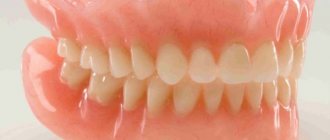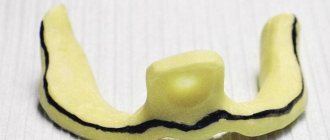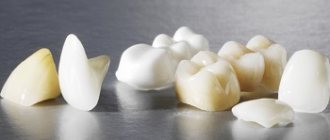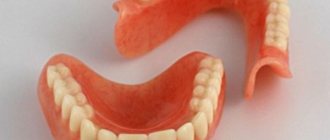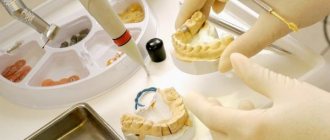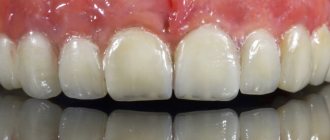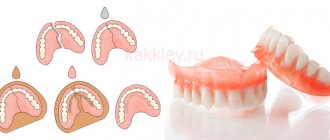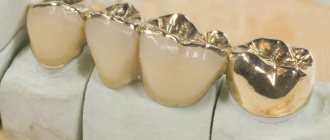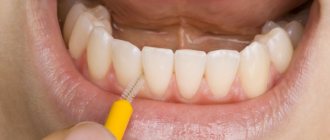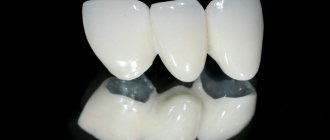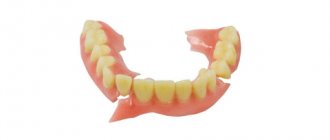During the Soviet period, the most common prosthetic technique with which it was possible to replace missing teeth was the installation of stamped crowns that formed a bridge using soldering.
Despite the fact that the technology is easy to implement, there is currently a downward trend in the popularity of its use in practice. The reason lies in low functional and aesthetic qualities, which are important characteristics in the work of modern specialists.
However, due to their affordable cost and ability to restore chewing functions, soldered dentures are still installed in many clinics today at the request of the patients themselves.
This article will tell you about the features of such structures, not forgotten by time.
General overview
A soldered bridge is a structure that includes several metal crowns that are soldered together. The method is considered outdated and has been used in dentistry since the times of the Soviet Union.
Most often, for the manufacture of such a structure, full stamped crowns are used, which securely fix the entire prosthesis.
Such products are secured using a special adhesive, sleeves equipped with pins and inlays. During the procedure, a specialist can use several technologies.
When doctors diagnose a patient’s tooth defect as newly acquired, and the adjacent units have maintained the correct position, installing a prosthesis does not cause difficulties. This means that the presented design is capable of completely eliminating small defects in the lateral units, usually on the movable jaw.
If the supporting organs have moved away from the destroyed unit, the parallelism of their clinical crowns is lost, which prevents optimal installation of the prosthesis. To prevent errors during the procedure, the doctor must prepare the supports in accordance with the rules.
Despite many years of practice by prosthetists in installing soldered bridges, the design features of such products do not allow them to fit tightly to the teeth. This contributes to the deterioration of the condition of the oral cavity during the operation of the prosthesis.
Under the crown, favorable conditions are created for the proliferation of pathogenic microorganisms, which spoils oral breathing and contributes to the development of various inflammatory processes.
Manufacturing stages
The process of manufacturing a plastic structure is carried out in several stages:
- The specialist prepares the teeth with an indentation, thanks to which it is possible to obtain a two-layer impression.
- The cast is sent to a technical laboratory, where a model is created based on it, the material for which is hard gypsum or its mixture with cement.
- Further modeling is done using pink or white wax. The natural anatomical shape of the supporting teeth is recreated.
- The body of the prosthesis and the wax composition are carefully glued together with wax.
- A simulated wax section is cut out from the resulting structure and plastered.
- Replace wax with plastic.
- After polymerization is completed, the finished prosthesis is processed and polished.
- Only after this is it transferred for subsequent installation in the clinic.
Despite the fact that plastic bridge structures are most often used as a temporary prosthesis before installing more reliable structures, their manufacture is taken as seriously as possible. The products fully correspond to the anatomical shape, due to which they do not cause obvious discomfort.
Indications and contraindications
Soldered bridges are recommended for installation if there is a need to restore lost teeth. This method is used if no more than 4 elements are missing in a row, while healthy elements must stand on the sides of the defect .
In addition, this model is used in the following clinical cases:
- pathological position of teeth, shape defects;
- violation of the integrity of the coronal part of the units;
- increased abrasion of the protective layer of teeth;
- abnormal bite;
- dysfunction of the masticatory muscles;
- microdentia.
The use of a soldered prosthesis is irrational in the presence of the following conditions and diseases, namely:
- end defects;
- absence of more than 4 adjacent bone organs in a row;
- pronounced mobility of the supporting elements located on the sides of the flaw;
- complex pathology of occlusion;
- advanced forms of periodontitis;
- tuberculosis and other serious diseases resulting from viral infection;
- grinding of teeth;
- severe damage to all elements of bone tissue, for example, osteomyelitis;
- psychoneurological pathologies;
- damage to blood cellular elements by various diseases (anemia, leukemia, hemorrhagic diathesis, myeloma, etc.);
- somatic disorders in aggravated form;
- poor oral hygiene.
Remarkable! Some of the above restrictions belong to the group of temporary prohibitions. After they are eliminated, you can begin prosthetics.
Let's figure out together which teeth are best to insert after molar removal and how much the procedure will cost. Come here if you are interested in whether it is possible to restore a chipped metal-plastic crown.
At this address https://dentist-pro.ru/protezirovanie/nesemnye/mosty/adgezivnyj.html we will consider the advantages and disadvantages of an adhesive bridge prosthesis.
Advantages and disadvantages of dental bridges
The main advantages of bridges made of metal-ceramics, plastic and other materials include:
- the design fits organically into the dentition, and the fastenings remain invisible;
- possibility of use in the absence of 1-4 units of teeth;
- maintaining clarity and articulation of speech, as well as chewing function;
- quick addiction in 8-12 hours;
- reasonable price, which can be adjusted through the choice of materials.
Studying the reviews, we can conclude that the benefits of a high-quality installation completely cover the cost of even the most expensive prostheses. However, it is worth mentioning the weaknesses:
- the need to grind abutment teeth;
- risk of traumatic occlusion of supports.
Some modern techniques allow you to avoid grinding, but they do not guarantee long service life and can quickly fail.
Production technology
The production of soldered bridge structures is a labor-intensive and complex process that consists of several clinical and laboratory procedures.
Therefore, to undergo this type of prosthetics, the patient needs to visit the clinic several times.
Taking impressions
Before starting to take impressions, which serve as the basis for making a prosthesis with optimal parameters, the doctor prepares the patient’s oral cavity for the upcoming procedures.
At the time of prosthetics, the health of all tissues and organs of the oral cavity should be normal . To achieve this, comprehensive measures are carried out aimed at eliminating existing pathologies and inflammations, as well as a comprehensive examination of the dentofacial apparatus.
If there are indications for installing the presented prosthesis model, in addition to professional cleaning and sanitation, thorough treatment of the supporting elements is carried out. If the clinical picture indicates that the pulp is unsuitable, it is removed.
At the next stage of preparation, the doctor grinds the supporting teeth. Removing a certain layer of dentin from these organs will help create additional space for secure fixation of crowns and ensure their optimal fit to the tooth surface.
Important! During the preparation process, the dentist also cleans the surface of altered carious tissues and old filling material, which minimizes the risk of developing secondary caries under the crown.
The procedure for turning supporting elements takes place under local anesthesia, if we are talking about living, non-pulpless elements. During the work, the doctor uses a bur with special tips of various shapes. To prevent overheating of the machined element, cooling with air or liquid is used.
At the final stage of preparatory measures, impressions of both jaws are taken. Alginate or other impression compounds are suitable for these purposes. After removing the taken impression from the oral cavity, it is disinfected.
If the copy of the elements of the jaw arch is clear, all the features of the bone organs and alveolar processes in the empty sockets are perfectly imprinted on it, the sample is sent to the dental laboratory.
Model making
In the laboratory, the technician begins his work by assessing the impression obtained. If the quality of the taken copy allows us to proceed to further production stages, he creates plaster models of the jaw.
Finished products are installed in the central ratio position. It is important to note that the intercuspal contact position of the teeth is individual for each patient.
Central occlusion is determined using special wax samples.
After determining the occlusion and central contact using plaster, the model is fixed in a special device, which was created to test the operation of artificial dental structures.
In dentistry, such a device is called an occluder. With its help, the technician can completely recreate the anatomical shape of the teeth and simulate the movements of the jaws in the open and closed position of the mouth.
Modeling the prosthesis body
After the gypsum mass has completely hardened, the model is rid of excess material that fixed it in the optimal position. Only the jaw model remains on the device.
Next, using wax, the stump of the prepared supporting elements is modeled, bringing its shape to the most natural appearance. The models remain fixed.
At the next laboratory stage, a technician cuts off the plaster with a special knife, making stamps.
Copies of cut dies are cast from metal alloys with a low melting point, which serve as the basis for stamping crowns that act as supports.
The finished products are transferred from the laboratory to the doctor for fitting in the patient’s oral cavity.
A crown intended for fixation on supporting units must meet a number of requirements, namely:
- ideally fit the natural shape of the bone organs;
- have a pronounced spherical surface that will protect the gums from food particles;
- the depth of immersion of the product under the gingival margin should be no more than 0.3 mm;
- overbite after installation should be excluded;
- ensure tight contact with the tooth surface and the area of the tooth neck;
- recreate the anatomical contact points of adjacent teeth.
If the crowns fully comply with the stated requirements and the doctor is satisfied with the design parameters, then he immediately makes impressions of them, which will serve as a model for modeling the body of the prosthesis.
Using the finished model, metal elements are cast from wax, which will subsequently replace the lost teeth. The crowns and impressions are again sent to the technician, who, following all the technical rules, will make the body of the prosthesis from wax.
Let's look at the steps of this procedure:
- the model is treated with water to prevent wax from sticking to it;
- the space between the supporting elements is covered with a wax roller, the volume and height of which exceeds the parameters of future new elements;
- The models of the upper and mobile jaws are fixed in the position of maximum intertubercular closure of the teeth;
- of the antagonist teeth is imprinted
- markings are placed on the roller , determining the number of intermediate teeth that form the body of the prosthesis;
- modeling of the chewing and vestibular surfaces of the restored elements is carried out.
The main stage of manufacturing the body of the structure is the formation of a prosthetic bed, which faces the gum tissue.
In order to avoid injuries to the surface of the tongue during the operation of the structure, the technician smoothes the transitions between the teeth on the oral side. Rounded bumps form on the chewing elements.
Casting
At the next stage, the wax model is redirected to the foundry. There, a metal product is cast on the basis of a wax sample.
Process algorithm:
- pins are installed in the wax product;
- a system of channels is created through which the molten metal will enter the casting mold;
- removing the wax composition from the model;
- creation of a casting tank;
- processing the wax composition with a facing layer;
- drying the coating;
- installation of a special metal form with a ward cone and a special additional element on the vibrator;
- pouring material for formation;
- release of the dental cuvette from the ward cone;
- removal of pins;
- wax melting;
- heat treatment of the mold;
- metal pouring;
- freeing the product from molding compounds;
- mechanical processing of the finished prosthesis body.
We will help you calculate how much it costs to insert a plastic tooth with temporary prosthetics. This article contains useful information about ceramic dental crowns.
Here https://dentist-pro.ru/protezirovanie/nesemnye/koronki/cirkonievaya-na-perednij-zub-opisanie-procedury-stoimost.html you will find objective reviews about zirconium crowns for the front teeth.
Soldering parts
After manufacturing all the parts of the future structure, the laboratory begins to connect them using soldering. For these purposes, a metal or alloy is used to fill the gaps between the parts being connected.
Solder must meet a number of requirements:
- to be soft (easy-going);
- have the property of being plastically or viscously deformed under the influence of temperatures;
- freely penetrate into the structure of the main material used;
- exhibit stability in acidic environments;
- have the same shade as the base material;
- correspond to the base metal in terms of chemical and mechanical characteristics;
- resist aggressive external influences and high humidity in the oral cavity;
- does not tend to swell during operation.
All elements of the future prosthesis are fixed with molding material. The structure is then placed in a special cabinet for subsequent heating by fire. After some time, the burner is turned down and the crowns are treated with a thin wick.
Solder is used until the gaps between the component parts of the structure are tightly filled.
Soldering steel crowns requires high professional skills from a specialist. If the primary stage of transition of the solder from the solid to the liquid state was missed, this threatens the appearance of an oxide film on the base material, which reduces the quality of soldering at the joints.
Finishing
After all production work has been carried out, the prosthesis is washed under cold water and the remains of auxiliary materials used during the formation of the entire structure are removed from its surface. Next, the product is bleached in a solution of hydrogen chloride.
Final finishing involves the use of a filing tool, artificial silicon carbide stones, and dental grinding discs.
With these devices, the specialist removes excess solder, smoothes out irregularities, processes the joints of elements and the occlusal surface of the crowns.
At the next stage of finishing, work is carried out aimed at polishing all components of the structure.
The final process is polishing. It is carried out using a special paste based on chromium oxide. After this manipulation has been performed well, the prosthesis is ready for installation.
Watch the video to see how bridges are installed.
Types of bridges
There are various types of bridges, differing in materials, manufacturing methods, location of the intermediate part, the nature of the adhesion of the elements and some other features.
Classification of bridges:
- By material: ceramic, metal, combined.
- By manufacturing method: cast, soldered.
- By fastening method: removable and non-removable.
- According to the position of the intermediate department: flushing and tangential.
- According to the position of the supports: double-sided and cantilever (when only one supporting tooth is involved).
- By type of abutment crowns: full, equatorial, inlays, pins, etc.
Bridging adhesive
The big advantage of this design is its installation using glue. Turning is not used in this case. Using this technology, the dentition is restored in a short time. This is a positive moment for both the patient and the doctor.
Solid bridge
The product is made using special casting. The advantage is that the crown itself fits firmly to the ground tooth, so the places in contact with the gum and possible gaps are not clogged with food debris.
This type completely eliminates destruction. There are also disadvantages to this design. This is primarily a great sensitivity to hot. A person experiences unpleasant sensations when eating hot food.
Metal-ceramic bridge
This product combines the advantages of ceramics and metal. The main indicators are biocompatibility in oral tissues and the fairly high strength of the material itself. Also, the appearance looks quite aesthetically pleasing and beautiful. In case of diseases with gums and in the absence of more than 4 teeth in a row, it is better to abandon the metal-ceramic type.
This is interesting: What is chewing efficiency according to Agapov
Bridge stamped and soldered
This method is considered the oldest and has been used since Soviet times. Made from a thin-walled sleeve shell. This occurs during the process of compressing a plaster copy of the tooth. At the joints they are soldered, which ensures a continuous connecting structure.
Disadvantages can be considered:
- the impossibility of creating an exact shape due to a loose fit,
- using this type of prosthetics, there is a high probability that caries will form in the future and this will lead to tooth loss,
- the walls turn out to be thin and, as a result, quickly wear off, which leads to destruction and breakage.
- Patients experience bleeding from the gums and an unpleasant metallic taste due to metal oxidation.
Bridge ceramic
This is a modern type of prosthetics, where zirconium oxide is used in manufacturing; this material is considered the most compatible with tissues in the oral cavity.
Ceramic products perfectly match the color scheme and shape of the tooth.
Bridged Maryland
In prosthetics, this design is used with submerged supports. It differs from the classic type in that not complete, but partial turning is carried out in the places selected for supports; small cavities are made there for immersing the legs of the prosthesis into them. Subsequently, the cavities are closed with fillings.
Advantages and disadvantages:
- The main positive quality of this type is considered to be preservation of the pulp and minor removal of enamel. Therefore, gum disease is excluded in this case.
- This type of prosthetics is used only if the supporting teeth are healthy.
- The prosthesis is considered ideal only for temporary restoration.
- The product itself is not durable, since the legs cannot withstand heavy loads and can become cemented.
- In modern practice, the Maryland method is used only in the front rows.
Bridges supported on tabs
Not only full crowns, but also metal or ceramic inlays can be used as supports. Metal structures are manufactured using the casting method, ceramic ones using CAD/CAM technology. The main difference between such dentures is that there is no need for extensive preparation of the supporting teeth - it is enough to make recesses for the inlays. Read more about adhesive prosthetics→
All-ceramic bridge prostheses
Ceramic bridges are manufactured using digital CAD/CAM technology from a single block. This process is quite complicated - the supporting teeth are ground and scanned, after which the frame of the future prosthesis is modeled on a special computer on a three-dimensional model of the jaw. The structure is produced by milling from zirconium dioxide blocks on a special machine. The last stage of production is firing and applying porcelain mass to the frame.
All-ceramic bridges have excellent aesthetics, fitting tightly to the stump of the supporting teeth and completely imitating the anatomical shape of the teeth. The main disadvantage of such designs is their high cost compared to other types of prosthetics. Read more about ceramic crowns→
Cantilever bridge prostheses
A cantilever bridge differs from a conventional one in that only one tooth on one side is supported. This design is used when the patient is missing one tooth in the dentition, most often in the anterior section. The part that hangs over the defect area is called the console.
It is not recommended to use cantilever bridges to restore missing molars - when chewing, the load is distributed unevenly, causing loosening of the supporting tooth. In addition, the bridge in such a situation begins to act as a lever, which is why the structure may overturn.
Removable bridges
A removable bridge is a structure consisting of supports that transmit chewing pressure to the dentition through clasps or special locks - attachments. This design is used in cases where fixed prosthetics are impossible for one reason or another.
Pros and cons of the design
In recent years, prosthetics with soldered bridge structures have become increasingly popular. According to doctors, this is due to the negative impact of low-quality metals used in the manufacture of prostheses on the oral mucosa.
In order to appreciate the feasibility of installing such products, it is necessary to become familiar with their real advantages and disadvantages.
Pros:
- thin walls of the crowns, which does not require significant turning of the supporting elements;
- low cost;
- simplified installation algorithm that does not require the use of special types of tools.
There are a lot of disadvantages to a prosthesis:
- poor fit of the crowns to the supporting teeth , which contributes to the development of inflammation and destructive processes;
- rapid wear of product elements due to their thin walls;
- the occurrence of complications caused by the body’s reaction to substances contained in solder;
- unpleasant metallic taste in the mouth , which occurs due to the oxidation of metal by moisture.
- low strength index;
- weak equator of the chewing surface of the crowns , which disrupts the processes of primary food processing and leads to diseases of the mobile jaw;
- change in the shade of soldering points , which spoils the aesthetics of the entire dentition;
- the occurrence of allergic reactions to metal.
Structure
A distinctive feature of the design of plastic bridge-like processes is that the palate and upper jaws, rather than the toothless areas of the alveolar process, act as a support for them. Thanks to this, it is possible to transfer the load during chewing first to the mucous membrane and only then to the jaw.
The dentures are fixed with special hooks (clasps) connected to the base of the denture and fixing it on the jaw. They are installed linearly on the lower arc, and diagonally on the upper arc.
total cost
In Russian clinics, a steel bridge consisting of four crowns can be purchased for an average of 4,000 rubles.
The final price tag for this type of prosthetics depends on a number of factors, namely:
- number of missing teeth;
- number and type of activities aimed at preparing the oral cavity;
- prestige and pricing policy of the dental center;
- specialist experience;
- material used in the manufacture of the structure.
It is worth noting that today the presented prostheses are the most affordable method of prosthetics in the country.
